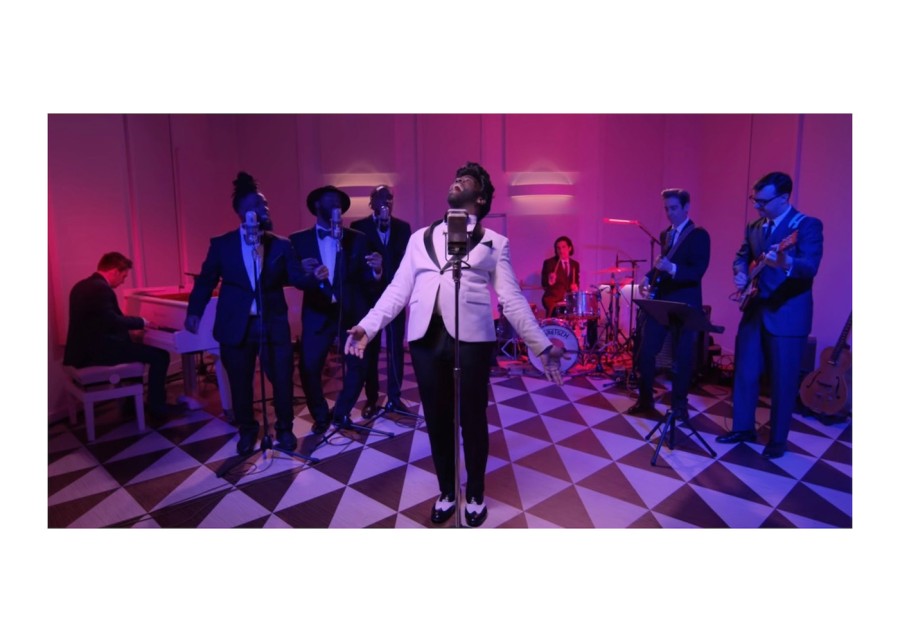Postmodern Jukebox: A musical time machine revives the jazz era
Scott Bradlee’s Postmodern Jukebox offers a riveting exploration into the history of the music world.
The Postmodern Jukebox converts modern pop hits into big band jazz tunes. (Courtesy of Scott Bradlee’s Postmodern Jukebox)
February 13, 2023
Postmodern Jukebox is a band that takes popular songs and alters their style to match different vintage genres. Founded by jazz pianist Scott Bradlee, the band intends to reinvent popular songs “in the light of classic and unfortunately ignored genres,” integrating styles ranging from the ’20s to ’60s into its covers. The band rose in popularity through its presence on YouTube — specifically thanks to its viral cover of Macklemore’s song “Thrift Shop” — and continues to release covers of songs by artists ranging from Taylor Swift to Chris Stapleton to the Backstreet Boys.
The band consists of pianist and music arranger Scott Bradlee, bassists Adam Kubota and Dave Tedeschi, drummer Arthur Vint and saxophonist Ben The Sax Guy. The vocalists change for each song, allowing the band to introduce singers on the rise as well as those who are better-known, regardless of whether they are jazz singers.
One of PMJ’s most popular covers, Radiohead’s “Creep,” is performed by “American Idol” finalist Haley Reinhart and amassed over 110 million views since its release date in 2014. While “Creep” is originally a rock song from 1992 mainly dominated by electric guitar, PMJ’s interpretation consists of a heavy use of piano and brass and woodwind instruments, initiating this song into the world of jazz. Reinhart’s deep, raspy voice intertwined with her whistle register allows for a multidimensional, yet well-balanced, auditory experience.
Not only does PMJ change the genre of the songs it performs, it also changes the style of their music videos to match with the recreated music genre. Furthermore, all of the band’s performances are filmed in a static camera shot, meaning that the entire video was recorded in one take. In “Creep,” the music video is in a black-and-white filter with a bordered vignette, allowing the brightness to center its focus on Reinhart and adding a vintage essence to the show.
In their music video “STAY,” PMJ performs in a ’50s diner-like setting. PMJ replaces the song’s original computerized beat with backup singers, a staccato piano technique and light incorporation of drums and electric guitar. There is a blue-and-pink filter on black-and-white tiles, and featured vocalist Freedom Young dances, smiles and sings in a light and playful voice, adding vibrancy to the video. The subtle improvisation emanates a home-like feeling, adding to the ’50s setting PMJ attempts to depict.
In a way, PMJ acts as a musical time machine. Reading about a specific time in history is one way to gain an understanding about how life was in the past. However, an immersive experience brings history to the personal lives of the viewer. PMJ could simply perform a cover of “I’d Rather Go Blind” by Etta James to lead their listeners to the ’60s era. Instead, they take a song that the present audience is familiar with and manipulate its style to fit a different moment in time.
PMJ changes the grunge and alternative rock form of “Creep” to a vintage jazz style dominantly present in the ’20s. They took “STAY,” a song written by pop artists less than two years ago, and manipulated it to make listeners feel as if it was released 70 years ago. PMJ flawlessly integrates the old and the new, the foreign and the familiar.
When one alters the structure of a song, they ultimately change the emotion emitted. The story in the song is still there — all that differs are the instrumental and stylistic elements. PMJ’s music videos feel alive, as if the band is performing for an audience right then and there. The music covers don’t sound superficial and forced; listeners can see and hear the subtle integration of the trumpet, or the faint-yet-consistent use of the bass. PMJ’s approach to improvisation in their recorded performances shows viewers that music does effectively have the ability to revive elements of the past.
Contact Afnan Abbassi at [email protected].



























































































































































